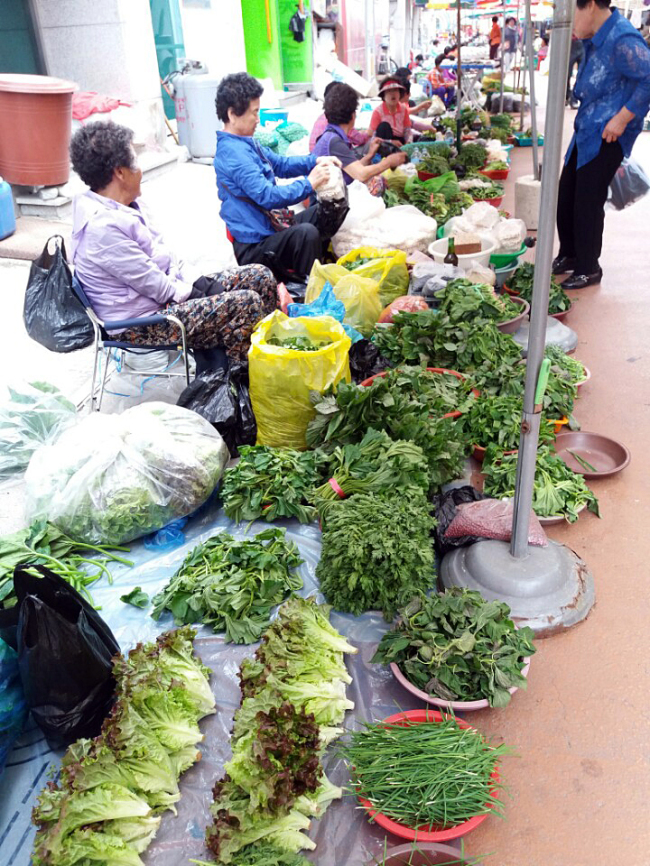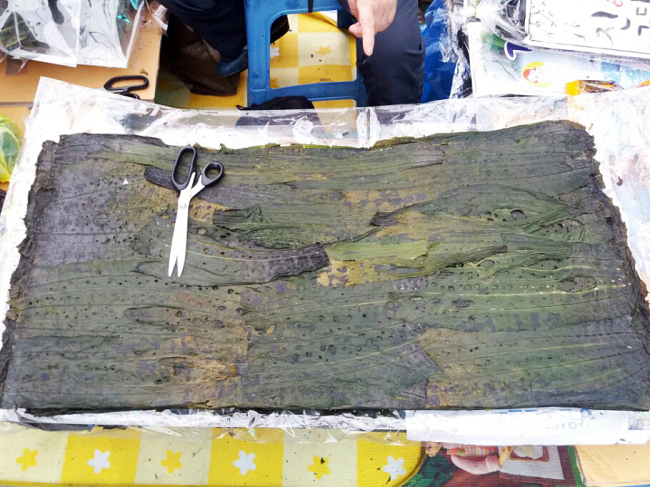Yangyang County in Gangwon Province is on the northeastern coastline of Korea and at the foot of the famed Seoraksan National Park. There you will find one of the oldest traditional markets in Korea commonly known as “five-day markets.”

At Yangyang, the traditional open air market is convened on days ending with a “4” or “9” each month. Most rural provinces throughout Korea are proud of their local markets and produce, which are a beautiful representations of the soil, land, climate and tastes of the region. Yangyang traditional market is special in that it is bookended by the clean cool waters of the East Sea and the lush northern mountain ranges that make for the best of both land and sea.
 |
Sellers dsplay their vegetables at Yangyang traditional market. (Christine Cho) |
On market day it is advised to arrive before 9 a.m., as with most farmers markets, if you want the first pick of the day’s best. A sea of rainbow-colored umbrellas cover a narrow alley where a hundred or more elderly women farmers sit on the ground and offer their produce and products, which usually sell out by lunchtime.
 |
Pressed laver at the Yangyang traditional market (Christine Cho) |
The charm of this alley is the camaraderie among the women, as well as the quality and quantity of each seller’s offerings. One farmer may have just a large basket of foraged mushrooms to sell, while the next farmer may have a handful of seasonal sour cherries, blackberries and radishes. Further down you might find a group of ladies helping each other prune vegetables. With a laid-back “we could care less if you buy it or not” attitude, it is refreshing to find this calm in a marketplace without the usual hustling and pushiness seen in markets anywhere else in the world.
 |
A songi pine mushroom local delicacy is shown with an honest display of what a songi mushroom looks like compared to the widely available genetically modified version. (Christine Cho) |
What is most charming and surprising at the Yangyang market is that the farmers don’t farm their products in large quantities, but instead maintain small plots or forage on the local lands of what is in season. The quality is pronounced for this reason. You won’t see paper twist ties or rubber-banded greens, but instead a small batch of a seasonal produce just enough to sell and earn a little cash to last until the next market day. Exploring the area on your own, you can see how easy it is to find wild cherries or honeysuckle throughout the land. This simple and honest display of sustainable living is heartwarming compared to the fast-paced world we live in today.
 |
Local stuffed squid specialty (Christine Cho) |
There are areas in the market that sell clothing, housewares, and local foods, rounding out the whole traditional market experience. It is advised to venture farther north to the underground Sokcho Fish Market, which has a better offering of seafood. Freshness abounds in Gangwon Province wherever you go, and experiencing this beautiful region of Korea is all very worthwhile.
By Christine Cho (
thepalatekorea@gmail.com)
Christine Cho, a Korean-American expat in Seoul, has been eating and cooking her way around the world for 16 years as a private chef. -- Ed.












![[Today’s K-pop] Blackpink’s Jennie, Lisa invited to Coachella as solo acts](http://res.heraldm.com/phpwas/restmb_idxmake.php?idx=644&simg=/content/image/2024/11/21/20241121050099_0.jpg)